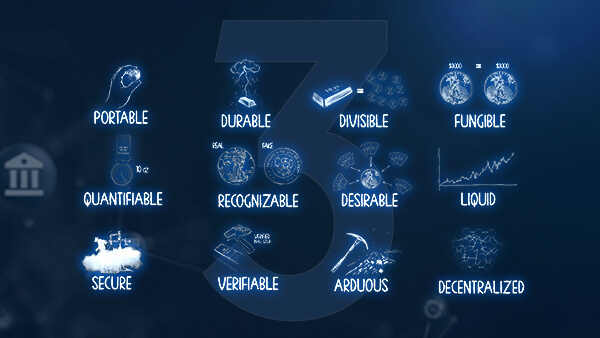Home / Hidden Secrets of Value with Alan Hibbard / 12 Properties of Money | Hidden Secrets of Value Ep. 3 | Alan Hibbard
Episode Three :12 Properties of Money


About This Episode
In Episode 3, Alan Hibbard unpacks the 12 essential properties of real money, showing us why only certain assets — like gold, silver, and potentially Bitcoin — can truly be considered money. These aren’t just nice-to-have traits — they are requirements for something to function as a store of value over time.Here’s a detailed look at each:
- Portable – Money must be easy to carry and transfer, both physically and digitally.
- Durable – It must resist decay or corrosion; it shouldn’t degrade or spoil over time.
- Divisible – You should be able to divide it into smaller units, and recombine them, for everyday use (e.g., making change).
- Fungible – Each unit should be equal in value to every other unit of the same size. No unit is “better.”
- Quantifiable – You must be able to measure how much of it you have, precisely and consistently.
- Recognizable – Everyone should be able to easily identify it and distinguish it from more or less valuable items.
- Desirable – People must want to hold it, buy it, or earn it, knowing others will too. This creates demand and liquidity.
- Liquid – There must be a well-established, accessible market for it. You should be able to buy and sell easily.
- Secure – It should be hard to counterfeit, forge, or duplicate dishonestly.
- Verifiable – People should be able to confirm its authenticity with ease.
- Arduous – New units must be difficult and costly to produce. This is crucial to preserving value.
- Decentralized – There must be no central authority able to control its issuance, rules, or availability.
Alan emphasizes that these 12 traits aren’t arbitrary — they’re deeply connected to energy and effort. Real money stores energy because it took energy to earn and to create, and furthermore, there’s a reasonable expectation that the next unit will take energy to create too.
Key Question
What are the 12 essential properties that make something good money, and what happens to the value stored in a money that lacks one or more of these properties?
Store of Value
The value ‘in’ a store of value is the energy you spent to acquire it. If units are effortless to acquire, value will NOT be stored.
Key Insight:
A ‘store of value’ isn’t just something that retains its physical properties – it’s something that also can’t be produced easily by others.
Practical Takeaway:
If something is easy for others to produce, such as dollars, then you should probably hold something else instead.
Scarce vs. Arduous
Scarcity doesn’t make something a store of value. A store of value needs to be Arduous.
Key Insight:
Many items are scarce, but are worthless. To ensure that what you’re holding stays valuable, it must be effortful for someone to create or acquire a new unit.
Practical Takeaway:
Ignore coins or assets that claim to be valuable because of their scarcity. Focus on assets that are hard to produce.
Intrinsic Value vs. Extrinsic Value
Intrinsic Value comes from what something is. Extrinsic Value comes from how others treat it.
Key Insight:
Physical and chemical properties are fixed, but laws, beliefs, and trends are not. What’s money may shift over time because of changes in perception.
Practical Takeaway:
Choose money today that you expect to be money tomorrow. Focus not just on physical properties, but behavior patterns among people, companies, and governments.
Monetary Value
Money has extrinsic value because we plan to trade it, not to consume it.
Key Insight:
If people intend to consume something, like food, then they’re primarily valuing it for its intrinsic value. If they intend to trade it, like dollars, gold, or bitcoin, then its valued primarily for its extrinsic value.
Practical Takeaway:
Hold some items because you plan to use them. Hold monies and currencies because you plan to trade them.
Floor of Value
Intrinsic value is a floor of value; it is not a prerequisite for monetary value.
Key Insight:
If any item loses its social value due to legal changes, fashion changes, or just changes in tastes and preferences, its market value will fall from its extrinsic value to its intrinsic value.
Practical Takeaway:
If you want to ensure that your money doesn’t go to zero, then you need to hold something with intrinsic value. Otherwise, you don’t.
Ready to Take Action?
Apply what you’ve learned and start building your financial future today.
